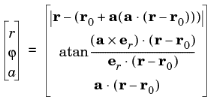A Cylindrical System ( ) can be used in 2D and 3D where rotational symmetry about the axis is required. The cylindrical coordinate system is not applicable in geometries with 2D axial symmetry. The local coordinate system is defined by (r,
) can be used in 2D and 3D where rotational symmetry about the axis is required. The cylindrical coordinate system is not applicable in geometries with 2D axial symmetry. The local coordinate system is defined by (r,  , a), where r represents the radial distance from the longitudinal axis,
, a), where r represents the radial distance from the longitudinal axis,  is the azimuthal angle (in the interval from −π to π), and a is the distance from the origin along the longitudinal axis. In 2D models, only the origin can be specified, whereas in 3D models, the longitudinal axis direction, a, and the radial base vector, er (
is the azimuthal angle (in the interval from −π to π), and a is the distance from the origin along the longitudinal axis. In 2D models, only the origin can be specified, whereas in 3D models, the longitudinal axis direction, a, and the radial base vector, er ( = 0), can be specified as well. These direction vectors are automatically normalized.
= 0), can be specified as well. These direction vectors are automatically normalized.
The definitions of the cylindrical coordinates in terms of the global Cartesian coordinates r = r(x, y, z) are
Select with respect to which Frame—Spatial (the default), Mesh, Material, or Geometry—the coordinate system is cylindrical as defined by the above transformations. Note that the actual coordinate names—typically (x, y, z) or (X, Y, Z) in 3D—are displayed for each frame, indicating which frames differ from each other in the current model.
|
A coordinate system with Frame set to Spatial is orthonormal only in the spatial frame. Similarly, a Material system is orthonormal only in the material frame. Some physics require that coordinate systems used are orthonormal in a particular frame. For example, choose the Material frame if you want to use the coordinate system in a structural mechanics model.
|
In the Coordinate names table, the default Coordinate names are entered—r, phi, and a. In planar 2D models, r and phi are in-plane polar coordinates, and a is the out-of-plane coordinate. The labels for each coordinate name—First, Second, and Third—include the default name in parentheses.
Specify the location of the Origin of the cylindrical coordinate system in the global Cartesian system. The default is an origin coinciding with the one from the global system.
For 3D models, enter the Longitudinal axis direction. The default is the z direction in the global system.
For 3D models, specify the Direction of axis  =0, where
=0, where  is the azimuthal angle. The default direction is the x direction in the global system.
is the azimuthal angle. The default direction is the x direction in the global system.
|
Go to Name for information about the Settings window Label and Name. Also see Settings and Properties Windows for Features Nodes.
|
